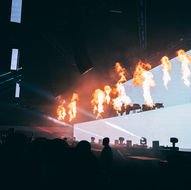How Gen Z Is Remixing EDM: From Bedroom Beats to Global Stages
- Skhumbuzo Msimanga

- 4 days ago
- 4 min read
There’s a new wave in EDM, and it’s not coming from giant studios or legacy labels. It’s coming from bedrooms, dorms, and makeshift home studios. Gen Z producers are reimagining the path to “making it.” They’re building with AI, social platforms, modular gear, and cross-genre daring. The result? The blueprint for EDM’s future is changing — and rapidly.

Once upon a time, access to professional studios separated popular artists from hobbyists. Now, those tools live inside a laptop. As DAWs and plugin suites have grown more powerful and affordable, producers can deliver polished, festival-ready tracks from home. The rise of ghost production, remote collaboration, and beat marketplaces means even young creators can monetize their work before establishing a name. On top of that, AI is accelerating what’s possible. AI vocal tools let non-singers layer harmonies, clone voices, and produce full vocal parts, turning what was once a barrier into a creative option. Feedback tools like AI TrackMate are giving independent producers constructive critique on mixes, allowing them to self-audit without mentors or expensive studio time. The effect is simple but seismic: artists who once needed years of access to hardware and collaborators can now launch their careers from their dorm rooms.
Gatekeepers are loosening their grip, too. Getting signed or booked no longer requires industry connections when a single viral moment can change everything. A 30-second hook on TikTok or Instagram Reels can blow up overnight and lead to festival invitations. Publications like DJ Mag are regularly highlighting rising creators, and platforms like SoundCloud and streaming playlists give unknown producers global reach before they’ve built local followings. Artists like Aaron Hibell, Adjuzt, and ASHEZ are prime examples — emerging names appearing on “artists to watch” lists after online buzz alone. In 2025, streaming numbers, playlist placements, and algorithmic discovery play an outsized role in defining who breaks through.
Gen Z is also leaning heavily into new technology to shape their sound and workflow. Platforms like Suno, Udio, and LANDR are now fully integrated into production setups, helping creators generate musical ideas and automate mastering with ease. AI has also entered the DAW itself. FL Studio 2025 introduced Gopher, an in-DAW assistant that offers mixing tips, theory help, and arrangement suggestions on the fly. Voice cloning and AI vocals have become commonplace, removing the need to chase singers or external collaborators. Even more futuristic tools, like real-time generative composition systems, hint at a future where live sets and tracks can evolve dynamically in response to audiences.
Not everyone is sticking to software, though. Many Gen Z producers still love tactile creation, using modular synths, Eurorack, and hybrid setups to shape their sonic identities. These instruments aren’t just for sound — they’re also part of a visual identity strategy. A video of someone patching modular gear or triggering pads can be as compelling to watch as the track itself. On top of that, AI feedback systems are giving producers near-instant mix and structure analysis, flattening the learning curve and speeding up their journey from idea to release.
Sonically, this generation is also refusing to color inside the lines. Hyperpop’s synthetic, distorted energy is bleeding into club electronics, merging glitch, pop, noise, and heavy club rhythms. EDM is colliding with drill, rap, trap, lo-fi, and even regional sounds to form new, genre-fluid aesthetics. Localized influences are shaping what EDM sounds like globally, and the result is a landscape that’s far less centralized than it was in the early 2010s.
The artists leading this shift prove just how decentralized the scene has become. Aaron Hibell, Adjuzt, ASHEZ, SHIMA, Kotiēr, Loverground, and Nimino are just a few of the names making waves. They’re appearing on rising artist lists, headlining smaller festival stages, and amassing loyal online fanbases — often before their first international tour. Even major festival bookers are paying attention to how these young artists are pushing sonic boundaries.
Of course, this revolution comes with its own set of challenges. With lower barriers to entry, the scene is more saturated than ever, making it harder to stand out. Viral plays don’t always translate into sustainable income, and many producers are still figuring out how to turn online traction into real-world careers through touring, merch, and sync deals. Traditionalists still value “studio pedigree,” and questions around AI ethics — like vocal cloning and sample ownership — are becoming increasingly urgent. Over-reliance on AI could also risk flattening individuality if artists lean too heavily on templates.
But even with those hurdles, the future is bright. AI-augmented live shows that adapt to crowd energy, fan-driven production where audiences vote on drops or stems, and micro-festivals curated by Gen Z for Gen Z are already on the horizon. EDM is no longer a top-down industry; it’s an ecosystem built collaboratively, line by line, beat by beat.
Gen Z isn’t just remixing music — they’re remixing the entire system. The future of EDM is being built in bedrooms, broadcast to the world through algorithms, and embraced by fans everywhere. The next superstar isn’t in a traditional studio. They might be uploading their first viral track tonight.
































Comments